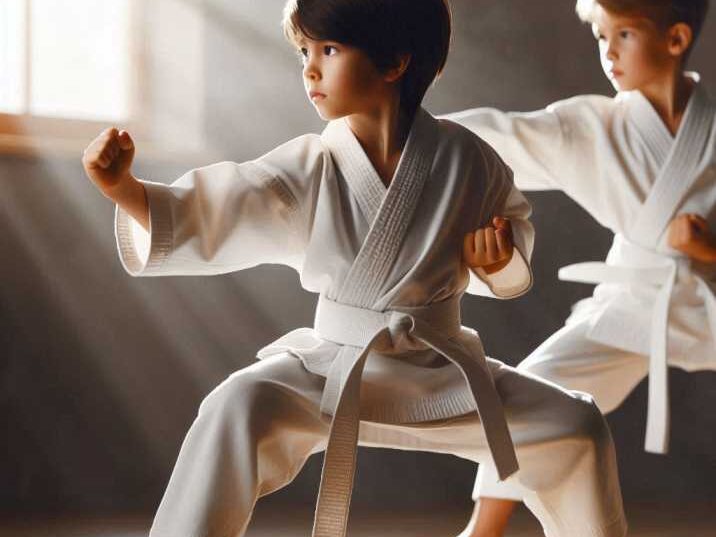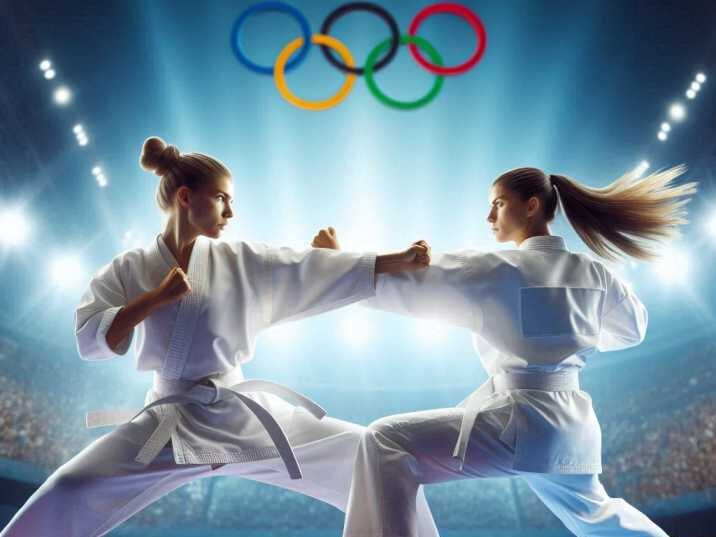Introduction
Table of Contents
Karate is an exciting martial art that many people around the world love. But have you ever wondered, is Karate an Olympic sport? The answer is yes! Karate became an official Olympic sport in the 2020 Tokyo Olympics. In this article, we will explore what makes Karate unique, how it became part of the Olympics, and the benefits of practicing Karate, especially for kids. Whether you’re a beginner or just curious about Karate, this guide will help you understand everything you need to know.
What is Karate?
Karate is a martial art that originated in Japan. It involves using punches, kicks, and defensive blocking with arms and legs. Unlike some sports, Karate doesn’t use weapons. Instead, it focuses on developing discipline, self-control, and physical fitness. Practicing Karate can help kids build confidence and learn how to stay calm in stressful situations.

Is Karate an Olympic Sport?
Yes, Karate is an Olympic sport. It made its debut in the Olympics during the 2020 Tokyo Games. This was a significant milestone for Karate because it showcased the sport to a global audience. There are two types of Karate events in the Olympics: Kata and Kumite.
- Kata is a demonstration of Karate techniques. Athletes perform a series of movements that include punches, kicks, and blocks. They are judged on their speed, power, and precision.
- Kumite is a sparring event where two athletes compete against each other. Points are awarded for landing strikes on specific target areas on the opponent’s body.
How Did Karate Become an Olympic Sport?
Karate’s journey to becoming an Olympic sport was long and challenging. For many years, Karate enthusiasts campaigned to include the sport in the Olympics. The inclusion of Karate in the 2020 Tokyo Olympics was partly due to its popularity in Japan and worldwide. The International Olympic Committee (IOC) decided to add Karate to the Olympics to appeal to a younger audience and promote diversity in sports.
Why Karate is Popular Among Kids
Karate is a martial art that appeals to kids for its fun, active, and educational aspects. Here’s a closer look at the reasons why kids love Karate:
- Learning Self-Defense:
Karate teaches children practical self-defense skills, helping them learn how to protect themselves in various situations. This training boosts their confidence, making them feel more secure and capable both in and outside of class. - Improving Focus and Discipline:
Karate requires a high level of concentration to learn and execute moves correctly, fostering discipline in kids. This practice of focusing on instructions and refining techniques can translate into better concentration and discipline in school and other activities. - Building Physical Fitness:
Karate is a physically demanding activity that involves kicking, punching, and blocking, which keeps kids active and energetic. It helps improve their overall fitness, strength, flexibility, and endurance, contributing to a healthy lifestyle. - Encouraging Respect:
Respect is a core value in Karate, where kids learn to show respect to their instructors (sensei) and classmates. This emphasis on respect helps them develop good manners, humility, and positive behavior, both in and out of the dojo. - Making New Friends:
Karate classes provide a social environment where kids can meet peers with similar interests. They build friendships through shared experiences, teamwork, and support during practice sessions, enhancing their social skills and sense of community.
The Benefits of Karate Training for Kids
Karate offers many benefits for kids, both physically and mentally. Here’s a table outlining some of the key benefits:
| Benefit | Description |
|---|---|
| Physical Fitness | Improves strength, flexibility, and endurance. |
| Mental Focus | Enhances concentration and self-discipline. |
| Self-Confidence | Boosts confidence through mastery of skills and self-defense techniques. |
| Social Skills | Encourages teamwork, communication, and respect for others. |
| Stress Relief | Helps manage stress and emotions through controlled movements and breathing. |
Training and Competitions in Olympic Karate
Karate training involves learning various techniques and forms. In competitions, athletes are judged on their technical skills, timing, and ability to execute moves with precision and power.
Training Techniques
- Kihon: Basic techniques including punches, kicks, and blocks.
- Kata: Forms or patterns of movements that are practiced solo. It’s like a dance but with more powerful moves.
- Kumite: Sparring with a partner to practice attacks and defenses.
Types of Competitions in Karate
There are different levels of competitions in Karate, from local tournaments to international championships. Here are the main types:
- Local Tournaments: These are small-scale competitions where kids can compete against others in their age group.
- National Championships: The best athletes from each country compete to become national champions.
- International Competitions: These include the World Karate Championships and the Olympics.
Karate in the Olympics: Rules and Scoring
Understanding how Karate is scored in the Olympics can make watching or learning the sport more interesting. Here’s a detailed look at how points are awarded in Kumite (sparring) and how performances are judged in Kata (forms).

Scoring in Kumite
Kumite is a form of competitive sparring where two athletes face off in a match to score points by landing techniques on their opponent. The scoring system in Kumite is based on the accuracy, power, and technique of the moves. Here’s how the scoring works:
- Points System:
- Ippon (3 points): Awarded for a high kick (Jodan) to the head, a scoring technique delivered on a thrown or fallen opponent, or a technique executed on the opponent’s back.
- Waza-ari (2 points): Awarded for a middle-level kick (Chudan Geri) to the opponent’s body.
- Yuko (1 point): Given for a punch (Tsuki) to the head, face, or body, or a properly executed hand strike to a designated scoring area.
- Winning the Match:
- A competitor wins the match by having more points than their opponent at the end of the bout.
- 8-Point Difference: If a competitor leads by eight points more than their opponent at any time during the match, the match is stopped, and that competitor is declared the winner.
- Legal Target Areas:
- Points are scored when techniques are delivered accurately to specific areas like the head, face, neck, stomach, chest, back, and sides.
- Controlled Contact: Strikes to the head and neck must be controlled to avoid causing injury.
- Penalties:
- Penalties are given for prohibited behaviors like excessive contact, stepping out of the ring, or failing to show proper conduct.
- Penalties can lead to points being awarded to the opponent or disqualification.
Scoring in Kata
Kata is a performance-based event where competitors demonstrate a series of choreographed movements that represent defensive and offensive techniques. Unlike Kumite, Kata is judged by a panel of judges who score based on several criteria:
- Technical Performance:
- Judges assess the accuracy of movements, including correct posture, positioning, and the execution of each technique.
- Stances: Proper stances (e.g., front stance, back stance) are essential, and the transitions between stances must be smooth and correct.
- Techniques: Punches, kicks, and blocks must be performed with proper form and control.
- Athletic Performance:
- Speed: The speed of movements should match the requirements of the Kata, with faster moves where necessary and slower, more deliberate movements where appropriate.
- Strength: Techniques should be performed with power and intent, showing control and mastery over the body.
- Rhythm: Timing and rhythm are crucial in Kata, as they reflect the flow of a fight scenario. Movements should flow seamlessly from one to the next.
- Balance: Maintaining balance throughout the performance is critical. Judges look for stability and control, especially during kicks or complex movements.
- Winning the Kata Event:
- Competitors perform their Kata routines individually, and judges award scores based on the overall performance. The scores are then combined, and the competitor with the highest total score wins.
- Tie-Breaking:
- If two competitors have the same score, tie-breaking criteria, such as the difficulty level of the Kata performed or a second performance, may be used to determine the winner.
The Future of Karate in the Olympics
The inclusion of Karate in the 2020 Olympics was a significant achievement for the sport. However, Karate was not included in the 2024 Paris Olympics, which has sparked discussions about its future in the games. Many Karate enthusiasts are hopeful that the sport will return in future Olympic games.
Conclusion
Karate is not just a martial art; it’s also a valuable Olympic sport that teaches discipline, focus, and self-defense. For kids, learning Karate can be a fun and rewarding experience that helps them stay active, build confidence, and make new friends. Whether you’re interested in watching Karate in the Olympics or learning the sport yourself, Karate offers something for everyone. So, grab your Gi (Karate uniform) and start your journey today!
FAQs
- Is Karate an Olympic sport?
Yes, Karate was included in the 2020 Tokyo Olympics. - What are the two types of events in Olympic Karate?
The two types are Kata (forms) and Kumite (sparring). - Why is Karate good for kids?
Karate helps kids learn self-defense, improve focus, and build confidence. - Will Karate be in the next Olympics?
Karate was not included in the 2024 Paris Olympics, but it may return in the future. - What do you need to start Karate?
All you need is a Karate uniform (Gi) and a willingness to learn


